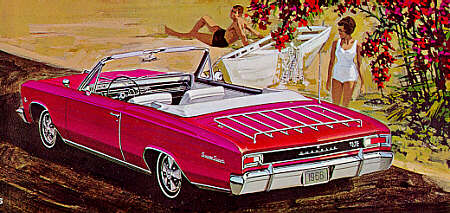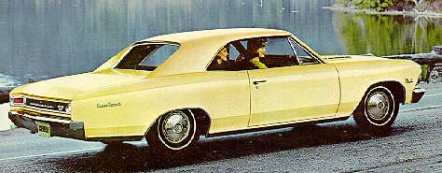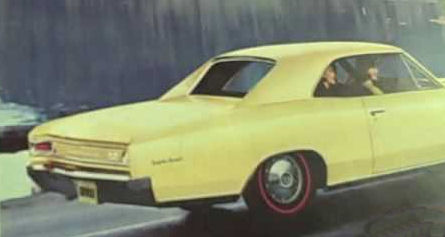1966 Chevelle Rear Cove Accent Panel
|
Reprinted courtesy of Bill Smith. This past summer at a Super Chevy event I came up on a group of 1966 Super Sport Chevelle owners discussing the rear panel on 1966 SS396 Chevelles. Every owner participating in the discussion said all 1966 SS396 Chevelles had body color only on the rear panel, and no 1966 SS396 Chevelles ever had the black rear accent panel. I knew some of the owners present, but not participating in the discussion, were long time owners of 1966 SS396 Chevelles with the rear black accent panels. For whatever reason those owners made no comment during the discussion. I also have been reluctant over the years to write anything regarding the black rear accent panel on 1966 SS396 Chevelles simply because each Fisher Body plant had their own policy, I have very little documentation to establish time frames that were in question, and most of my information is from the memories of GM employees. I'm motivated now to share what information I have because an original owner of a 1966 SS396 Chevelle with the black rear accent panel told me his friends had convinced him not to put the black rear accent panel back on his Chevelle for an upcoming restoration. I ask him what did his friends have to prove all 1966 SS396 Chevelles had rear body panels that were (lower) body color only? His answer was, "These guys have messed with Chevelles for years". The lower rear panel I'm talking about is the panel under
the trunk lid in which the trunk lock, Chevelle name, and the
rear SS/396 emblem mount on the 1966 SS396 Chevelles. The part
number for this panel is 7586821. First I would like to establish
some facts for consideration and for background.
I'm starting to sound like Joe Friday on Dragnet, "just the facts ma'am," so I will stop at this point. As you continue to read this please keep in mind this statement GM prints in most of the 1966 literature for consumer use, "All illustrations and specifications in this publication are based on the latest product information available at time of publication. The right is reserved to make changes at any time without notice in colors, materials, equipment, specifications, and models; also to discontinue items or models." What does all this information mean? I was puzzled until I meet two production line foremen that worked for Fisher Body, and one production worker that worked for Chevrolet at the Atlanta plant in 1966. These GM employees gave me a great deal of information that helped explain many questions I had regarding 1966 Chevelles. I'm going to share some of this information with you. This information is dealing with Atlanta built Chevelles, but could apply to other assembly plants within the GM network. To go further I need to give you some background that you may or may not know. Fisher Body and Chevrolet were two separate units all together in 1966. Fisher Body employees made the Chevelle bodies from raw materials and assembled the Chevelle bodies from the firewall back. Chevrolet employees only installed or assembled the parts on Chevelles that were made and shipped in from other satellite plants. The Fisher Body foremen told me any decision regarding the rear black accent panel on 1966 SS396 Chevelles would have been made by Fisher Body, with the knowledge of Chevrolet management. Early in the 1966 production year the demand for the 1966 SS396 Chevelles in the Atlanta region was greater than anticipated. The Fisher Body line was very labor intensive, and Atlanta Fisher Body production had gotten behind Chevrolet orders by as much as six weeks. A new 1966 SS396 Chevelle took three days to cycle through the assembly line process from the issuance of a Fisher Body assembly line sequence number to the finished product that was driven off the assembly line. Other Fisher Body assembly plants that were producing Chevelle bodies were staying closer to the production demands than the Atlanta Fisher Body plant. Early in the 1966 production year changes that had been made to increase production at other Fisher Body assembly plants were being implemented at the Atlanta Fisher Body plant. One of the changes that went into effect was to install fewer time consuming accessories on cars that were produced for dealership inventories and not specific customer orders. GM had a policy of installing several accessories on the early production cars so consumers would see the accessories and want then on cars during the production year. Another change was to defer installation of some customer requested accessories to the dealerships after delivery of the cars. Also the black rear accent panel that was being painted on 1966 SS396 Chevelles had been dropped to save time and labor. One of the Fisher Body line foreman told me the cost of the black rear accent panel was included in the cost of the Super Sport option, which would explain why only 1966 SS396 Chevelles had this feature. Near the end of the Atlanta Fisher Body 1966 production year customer demand for the 1966 SS396 Chevelles had been met. The cutoff date for dealers to special order the 1966 models had passed. Fisher Body in Atlanta had received information that all 1967 SS396 Chevelles would have a mandatory black rear accent panel. Near the end of the Atlanta Fisher Body 1966 production year a 1967 SS396 Chevelle was run down the line to check quality and for production information for the coming 1967 model year. I was told this 1967 SS396 Chevelle was pulled from the line, inspected and later destroyed. Shortly after this point Fisher Body in Atlanta did reinstate the black rear accent panel on very late production 1966 SS396 Chevelles. None of the GM employees could remember or even say they were given a reason for the reinstatement of the black rear accent panel on late production 1966 SS396 Chevelles. Both Fisher Body foremen seem to think reinstating the black rear accent panel late in the 1966 production year on the 1966 SS396 Chevelles produced in Atlanta was in preparation for production of the 1967 SS396 Chevelles. No one could give me any kind of date for these or any of the other mentioned changes, other than it was early or very late in the 1966 production year in the Atlanta Fisher Body plant. All these changes that I have mentioned would explain the changes seen in the Chevrolet literature that I mentioned earlier. At this point I want to mention I have owned many original paint 1966 SS396 Chevelles over the last thirty years, and few had the black rear accent panel. I have talked to original owners of 1966 SS396 Chevelles with photos of their new cars and the vast majority did not have the black rear accent panel. I lived across the street from my local Chevy dealer from '52 until '68 and remember three L78 1966 SS396 Chevelles very well. All three Chevelles were Atlanta built cars. The first Chevelle was an Aztec Bronze early production car without the black rear accent panel. The second Chevelle was a Madeira Maroon midyear production without the black rear accent panel. The third Chevelle was a regal red fourth week of July car with the black rear accent panel. This third Regal Red 1966 L78 Chevelle has been sitting in my garage for over thirty years. I was there the night this car arrived on the truck, and have known the history of this 1966 SS396 Chevelle since day one. I have examples of 1966 SS396 Chevelles delivered to the dealership without the rear black accent panel only to have the dealership paint the rear panels black. A few years ago I talk to a body shop foreman that worked for a large Chevrolet dealer in Cincinnati, Ohio in 1966. He told me the sales manager had the rear panel painted black on all 1966 SS396 Chevelles with black vinyl tops and black convertible tops because they sold quicker. Keep in mind that some dealerships could have had examples of previously delivered cars on the lot with the rear black accent panel. Also showroom brochures, dealer albums and accessory books showing 1966 SS396 Chevelles with the rear black accent panel had been distributed to the public. The dealer could have painted the rear panel to promote sales or meet their customer's demands no matter when or where the cars were produced. In conclusion I think the evidence is very conclusive that some Atlanta 1966 SS396 Chevelles were factory produced with the black rear accent panel. These cars would more than likely be produced early or very late in the 1966 production year. Of the total production the percentage of factory produced 1966 SS396 Chevelles with the rear black accent panel should be very low. I would like to provide more specific GM documentation to illustrate my points and time frames, but at this time I don't have any. If any one has documentation to prove or disprove any of the points I have made regarding 1966 SS396 Chevelles produced in Atlanta or any other Fisher Body plant, please contact me at my e-mail address (bsmith@kih.net). I would be interested in discussing this issue with any one that has a interest and positive attitude. I hope this information will help those that are interested and open minded to understand the situation that existed in GM facilities in 1966. The one thing you can always say about GM , "Never say Never", when it comes to meeting production or making a dollar for the stock holders. |

 Home
Home Decode
Decode Tech
Tech Tools
Tools Dale's Coins/CDs
Dale's Coins/CDs Contact
Contact Chevelle
of the Month
Chevelle
of the Month Things
For Sale
Things
For Sale Custom
Stickers
Custom
Stickers



